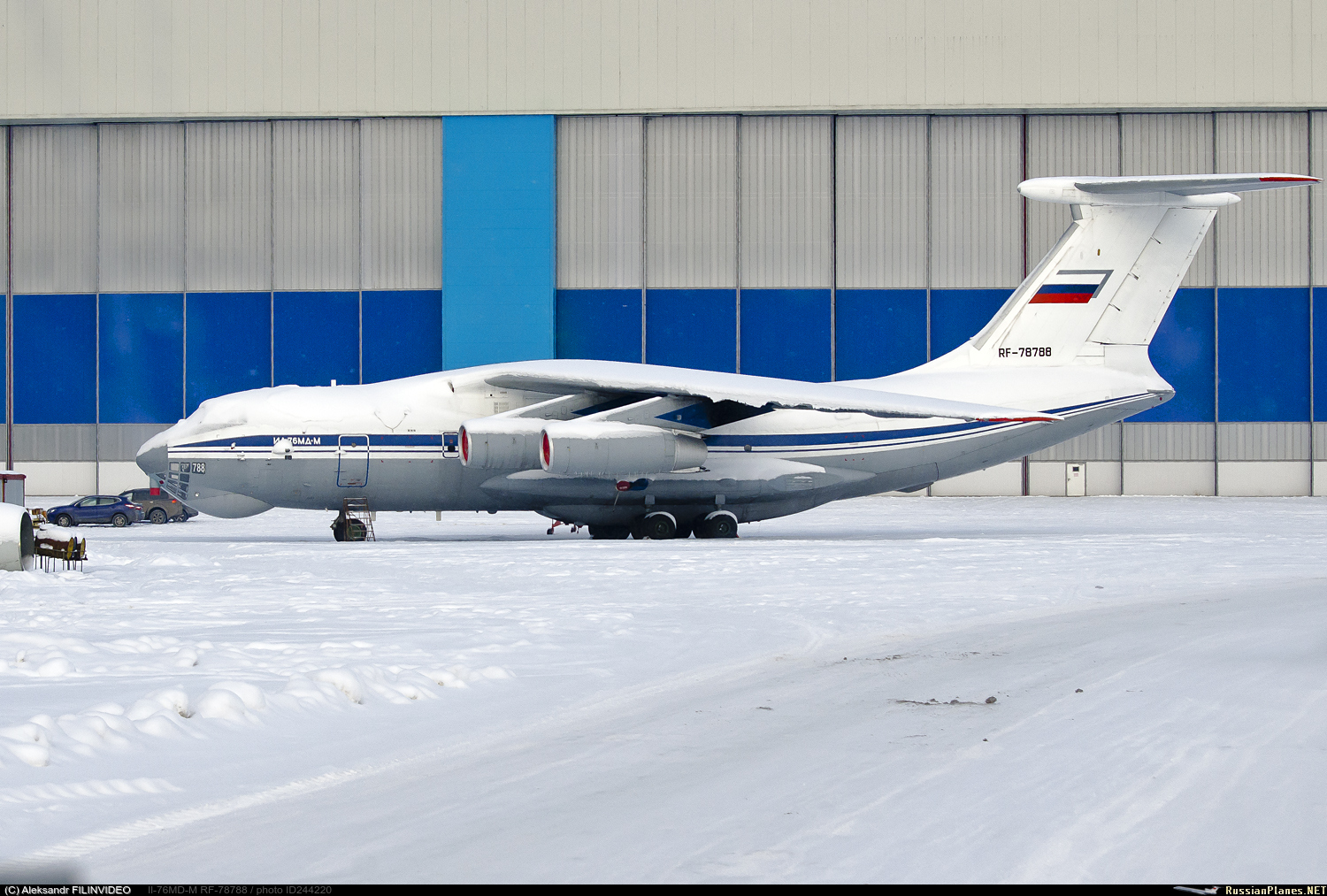Fleet of heavy auxiliary aircrafts of the Russian Armed Forces:
Data by weight class for the aircrafts of Russian and Sovietic origin, updated at the begin of 2019 from Russianplanes.net and other complementary sources:
1st Size Category: -
2nd Size Category: Active 012 Reserve 014 Production 1984-Today An-124
3rd Size Category: Active 003 Reserve 002 Production 1979-Today Il-86/80/96
Active 003 Reserve 006 Production 1966-1975 An-22
4th Size Category: Active 164 Reserve 058 Production 1973-Today Il-76/78/A-50
Active 007 Reserve 003 Production 1966-Today Il-62
5th Size Category: Active 006 Reserve 000 Production 1990-Today Tu-204/214
Active 020 Reserve 001 Production 1969-Today Tu-154
6th Size Category: Active 000 Reserve 000 Production 2010-Today Su-Superjet100
Active 035 Reserve 053 Production 1980-Today Mi-26/27
Active 000 Reserve 000 Production 1976-2003 Yak-42/142: http://russianplanes.net/planelist/Yakovlev/Yak-42
Active 063 Reserve 094 Production 1964-1989 Tu-134
Active 042 Reserve 007 Production 1959-1985 Il-18/20/22/24
Active 067 Reserve 052 Production 1957-1972 An-10/12
7th Size Category: Active 033 Reserve 014 Production 1985-Today An-72/71/74
Active 000 Reserve 007 Production 1960-1980 Mi-6/10/22
8th Size Category: Active 000 Reserve 000 Production 2018-Today Mi-38 (would need to reach around 16500 Kg of Maximum Take-Off Weight)
Active 162 Reserve 230 Production 1962-Today An-24/26/30/32
9th Size Category: Active 105 Reserve 000 Production 2009-Today Yak-130
Active 140 Reserve 065 Production 1979-Today Ka-27/28/29/31/32
10th Size Category: Active 000 Reserve 000 Production 1993-Today Che-22: http://www.airwar.ru/enc/sea/che22.html
11th Size Category: Active 050 Reserve 000 Production 2013-Today Mi-Ansat
Active 033 Reserve 029 Production 1966-1993 Mi-2
Active 047 Reserve 048 Production 1950-1991 An-2
12th Size Category: Active 041 Reserve 000 Production 2004-Today Ka-226
13th Size Category: Light material not exceeding the size of a car.
The previous data includes all the most modern successfull Russian and Sovietic heavy auxiliary/civil aircrafts and helicopters with production over 50 units, plus the Mi-38, which mass production begins now, is expected to be a success, and has been ordered by the Russian Armed Forces.
Foreign aircrafts that are likely to disappear soon from the Russian Armed forces (by sale, transfer to other governmental ministries or other way):
Active 031 Reserve 070 Production 1970-Today L-410 in the weight class of the Che-22Active 015 Reserve 000 Production 2009-Today An-148/158/178 in the weignt clas of the An-72/74Active 009 Reserve 000 Production 1997-Today An-140 in the weight class of the An-24/26/30/32Active 144 Reserve 000 Production 1977-1998 L-39 in the weight class of the An-2Green means production available for Russia. Blue means unlikely to reach the Russian Armed Forces. Purple is related with foreign and local aircrafts likely to disappear soon.
Between the 6 biggest categories aircrafts are dominant. Between the following 6 categories the helicopters would be dominant despite to be not present in all the categories, taking into account the success of the Mi-26/27 and the Mi-6/10 (bigger than the success of the An-72/71/74, with higher number of units produced). And in the smallest category trainer aircrafts would be dominant. In the future, for the heavy auxiliary aircrafts I would expect:
- Transport aircrafts to be successful in the 2nd to 6th categories (since 20 tons payload).
- Airliner aircrafts to be successful in the 3rd to 6th categories (since 95-100 passengers + mid range >5000Km).
- Helicopters to be successful in the 6th to 12th categories (until 20 tons payload).
- Trainer aircrafts to be successful in the 9th category.
The success is uncertain, even unlikely, for the rest of the options of heavy auxiliary material. Like overall rule, I would avoid to invest on them.
More explanation about, in the following link:
https://www.russiadefence.net/t4312p75-russian-transport-aircraft-fleet-vta#189143According to it, from a military point, this would be the
order of priority for auxiliary aircrafts and helicopters:0.- Su-SJ100 (I expect some order from the Russian Armed Forces in the short term).
1.- Ka-60/62 (in the
Che-22 10th size class with around 2.5 tons payload).
Vacant today.2.- Tu-330 (in the Tu-204/214 5th size class with around 40 tons payload).
Vacant today.3.- Mi-46/AHL (in the
Mi-6/10/22 7th size class with around 15 tons payload).
Successfull precedent almost retired.4.- Il-106/PTS Ermak 80 (in the
An-22 3rd size class with around 80 tons payload).
Successfull precedent almost retired.5.- Il-276 (in the An-10/12 6th size class with around 20 tons payload).
6.- PTS Ermak 160 (in the An-124 2nd size class with around 160 tons payload).
7.- Tu-304/Frigate Freejet (in the Il-62 4th size class for double configuration: 1 mid passenger capacity + long range, 2 high passenger capacity + mid range).
8.- New Aircraft (in the Il-76/78 Be-A50 4th size class with around 60 tons payload).
9.- CRAIC CR929 (in the Il-86/80/96 3rd size class for high passenger capacity + long range).
10.- Ka-40 Minoga (in the Ka/27/28/29/31/32/35 9th size class with around 5 tons payload).
11.- New Helicopter (in the Mi-26/27 6th size class with around 20 tons payload.
12.- MS-21/Yak-242 (in the Tu-204/214 5th size class for mid passenger capacity + mid range).
Note that the
PTS Ermak 240 would come as consecuence of the three sizes philosophy of the PAK-VTA project, but would not be prioritary in my view. The Il-PAK-TA is not in the list because would be for air transport in contested areas.
The
Mi-6/10/22 seems exhausted, pending total decommission.
I would expect the
An-22 to be used until to be totally exhausted in the short-term.
The
An-2/4/6 and the
foreing aircrafts need also a plan for total exhaustion.






